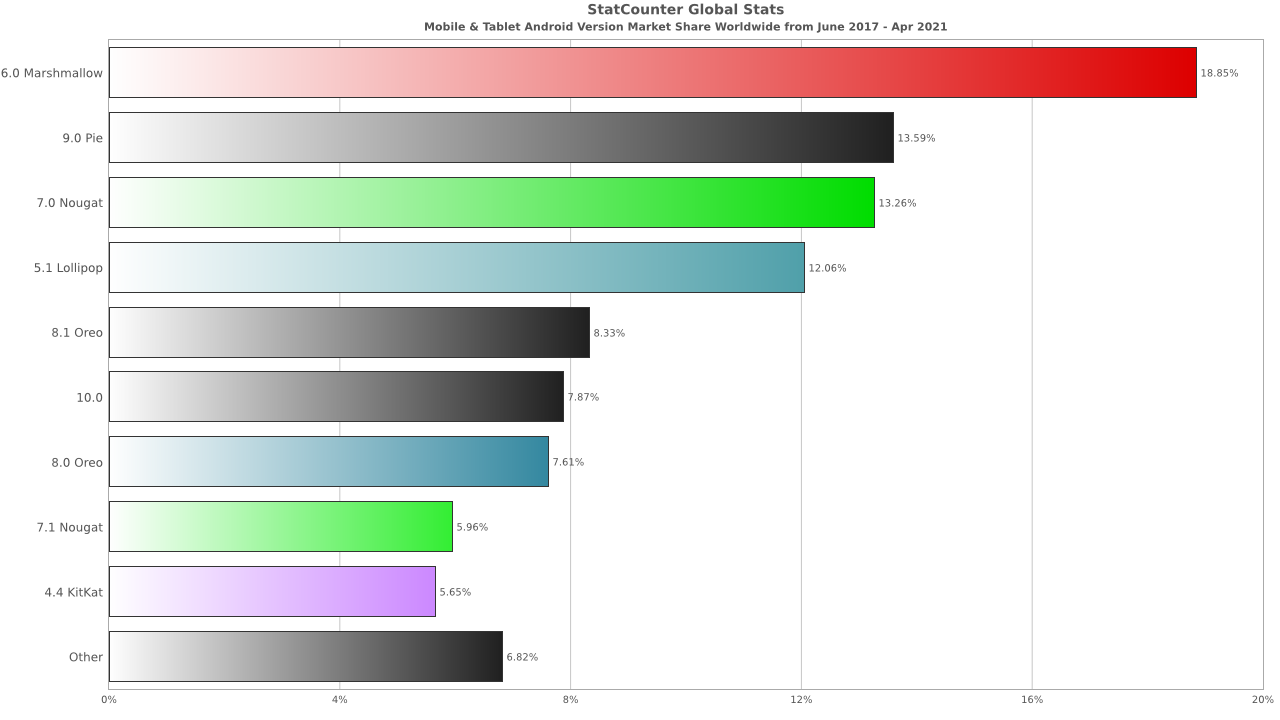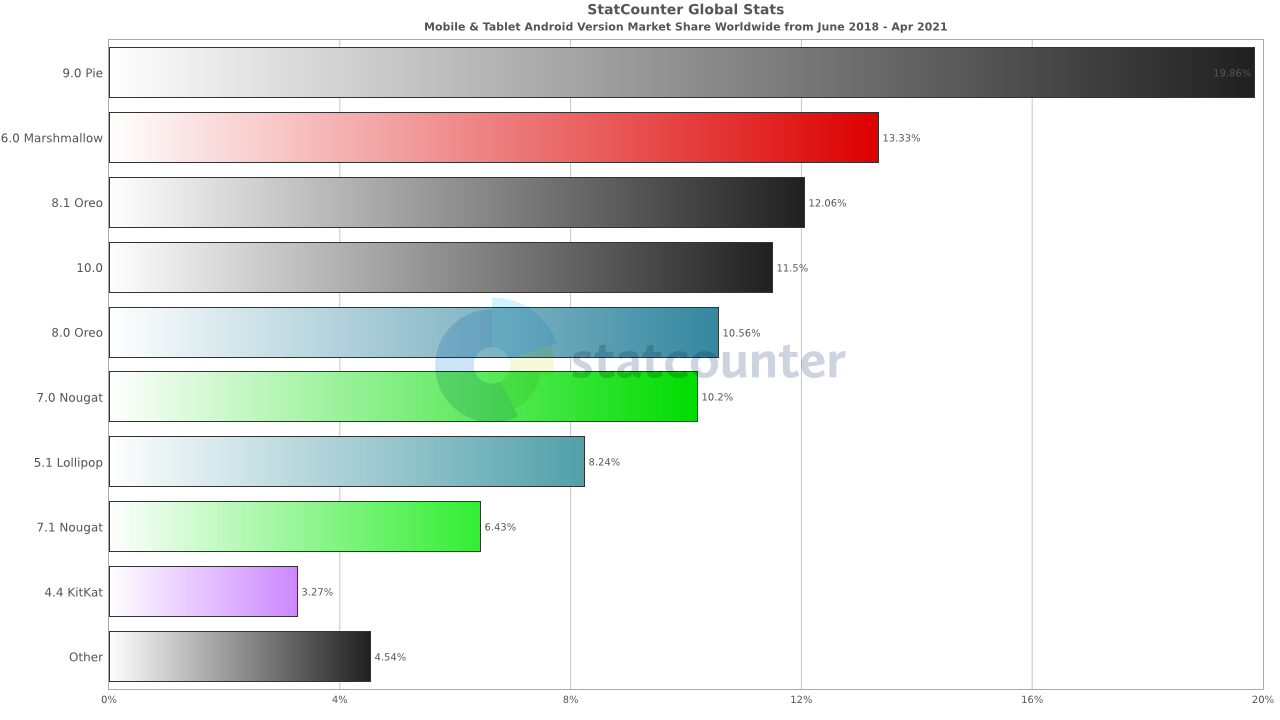Most of the refugees that visit this site typically wander over from my YouTube channel. So if you’re one of them; welcome one welcome all! In this month’s update I’m going to focus on my history with mobile gaming and how this is relevant to the recent release of Bluestacks 5. If you’re by and large uninterested with mobile gaming (and emulation) in general, this month’s blog might be a big snore fest for you. I’ll try and do a mini update midway between now and June for unrelated (non gaming) content.
Keep in mind the written portion of the update is going to be brief since I have a lot to say, and would rather you check out the audio version by clicking the little play button you see on top of this post. A lot of the finer details and nuances will be explained there while the text on the site will try and keep things brief and tidy. Let’s start off with some statistics courtesy of StatCounter.
In a nutshell, I’ve been gaming on mobile since 2011. So it’s been a decade since I got my first competent smartphone to do so; chiefly the Galaxy Nexus phone released in November 2011. Ever since then the industry has grown dramatically from rather niche “flash” style games to full blown AAA studio games you can play now on your phone. I didn’t really get interested into Android emulation however up until 2015 with the release of Bluestacks 2. Back then emulation of Android was a complete hot mess, and Bluestacks was the only thing that was able to make some sort of sense of it all. Granted BS2 ran like hot trash and was not an enjoyable experience whatsoever; but it got the job done. Since then a ton of other emulators have come and gone doing what BS does better or worse. We’re now here in the present with BS5 and a dramatic step forward in performance and usability over its recent iterations. But what does this all have to do with actual gaming? Hang in there, I got more history to explain before getting to the point.
There’s kind of an arms race right now going on in the mobile emulation scene. The thing is, up until about 2016 Android was relatively dominated by its older versions. This is because the market dictated it so. Android devices have always been affordable to the public at large, and this leads to weaker or older devices being in the hands of most people the world over. So even though a newer version of Android operating system may be released about every year; most folks who have smartphones are typically running one or two versions earlier. This is exasperated in developing countries where the gap becomes even wider. That all changed in 2019 however with the release of Android 10, and a serious push by Google to update its platform to a more “unified and modern” architecture. If you need further reading on the finer details about Android over the years, you can visit this link here by ComputerWorld which goes over other details not necessarily focused on gaming.
Basically, Google has taken a page out of Apple’s playbook by forcing folks to run better hardware to accommodate newer operating systems. This in turn has done 2 major things. It has forced a lot of developers (old and new) to adopt new technologies available to them while abandoning stuff they already were comfortable working with. It also has raised the bar for what games “can” be made on mobile platforms. Let’s refer back to the pictures above and show you the trend of major Android operating systems in use from June 2017. Each picture represents a leap of one year, and as you can see the dominance of Marshmallow in 2017 quickly fades away to “almost” the latest and greatest of Android 10 in the present time. For the younger folks out there - this isn’t normal. Not by a long shot in the last decade. The push towards modernization is very recent, and before 2016 most folks the world over were literally still using mostly Android 2.3.3 Gingerbread alongside Android 4.4 KitKat.
The game you see above is called Dragon Blaze from Gamevil. I actually played this game for quite some time, and believe it or not it was released globally in 2015 for Android Gingerbread 2.3.3 and up! It’s art direction is still fantastic, but the actual game itself is very antiquated by today’s standards. You see back then developers (and publishers) were aiming to make their game available to the widest amount of players possible. In order to do this, they had to limit their technical prowess by developing for older Android operating systems so that more folks could play their game. Fast forward to now…
You can see quite a dramatic shift on the technology front what is being pushed onto the mobile platforms. Games like Genshin Impact would of never been conceived to be possible a mere 5 years ago on phones, let alone now-a-days its almost becoming expected. This is because smartphones are getting stronger, more expensive, and Android as a whole is tightening its restrictions (and no longer supporting) older versions they consider “woefully” out of date. But this also reflects changes in consumer behavior; as more and more the world modernizes at a unified pace. Budget phones of today are what most folks consider mid-range a few years back. While top of the line phones of recent years can command prices of nearly (if not at) $1000 or more. The rise of the “minimum” standard in price goes alongside the dwindling upgrade cycle that use to be 2 years. Now that consumers are holding onto their phones for an average of 3 years (up 1 year as a whole prior to 2014) phones have to be more technically demanding to last the duration.
This is all on top of a populace that is getting older that has more disposable income, but are actually tech savvy unlike their predecessors. The demand for better and newer stuff is always growing, and recent shortages to provide such innovations possible only make the market demand it more than ever. Shortage on chips doesn’t help either in the current time.
So let’s bring this all back to Bluestacks and Android emulation in general. Remember for years, running older versions of Android were the norm for developers of apps and games. Now with a recent shift towards modernization, it’s becoming increasingly harder for emulators to keep up with newer games. Thus the need for better and faster emulators will be the “front lines” going forward in the next couple of years. If the emulators (regardless of whomever makes them) can’t keep up; we all might have to resort to treating newer smartphones as portable console devices. Let’s hope it doesn’t reach that point. That’s why I’m happy to see BS5 be released this month and run most games out there competently. At this rate, I wouldn’t be surprised if BS6 with Android 10 support is on the horizon for 2023.
In conclusion for this lengthy, singularly focused post I just want to emphasize the importance of getting a dedicated Android gaming device more so than ever. Used flagship phones about 2 years old can be extremely affordable and have enough horsepower to run an external display with mouse and keyboard support (via Bluetooth or dongle). You can really save a ton of money if you don’t care if the screen is damaged or even broken (as long as the video out works fine). Having an older laptop or computer running an Android emulator seems to becoming a thing of the past - especially considering the train wreck pricing of modern video cards.
Emulation (of Android) right now is in a tough spot, and I hope things start picking up for those of us interested in the hobby; specifically the gaming aspect of it.
Artist: Bluethebone






